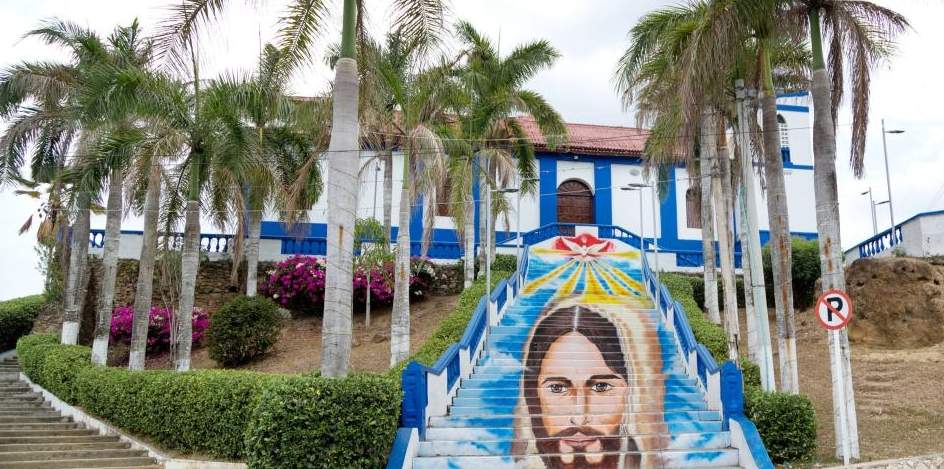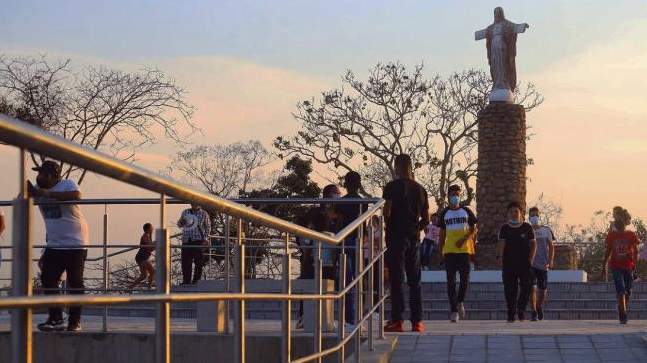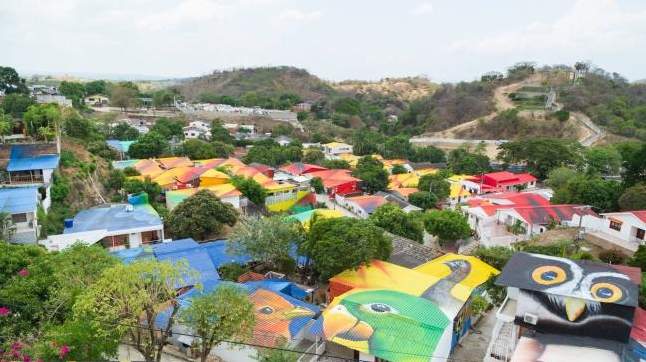
The Mirador Park was adapted by the Government to improve the experience of visitors
Usiacurí, or the manger of the Atlantic, as this municipality is known, is preparing to receive nearly 10,000 tourists, both national and international, during Holy Week.
This, due to its topography, its natural reserve, its striking colors, bird watching, and its artisanal tradition of weaving from the iraca palm.
Its particular geography, a town built between small mountains, and a church that stands out at its highest point and that allows, from there, a panoramic view of the entire municipality, makes people associate it with a manger.
In addition, it is known for its live Stations of the Cross, made by a group of more than 90 young people between the ages of 14 and 28, who personify the passion and death of Jesus. This tradition, which has been going on for more than 20 years, this year will take place on April 15, Good Friday, in the Main Square from eight in the morning.
Hundreds of people used to walk and climb the 45 meters between the brush and the mud, in the absence of a structure or steps, to reach the image of the Sacred Heart of Jesus, located at the top. And it was during Holy Week when a greater number of people went up to make the pilgrimage.
However, now the panorama is different, thanks to a series of interventions made by the Government of the Atlantic in the Mirador Park, as the place was baptized, to improve the experience of the visitors who go up to see the Sacred Heart of Jesus in the top.
“Through the ‘Parks for People’ program, this project was carried out in which 4,932 square meters of public space were recovered to strengthen it as the new religious destination of the department,” explained Elsa Noguera, Governor of Atlántico.
After 11 months and 28 days of interventions, in February 2022, and thanks to an investment of 7,300 million pesos, the Government of Atlántico put the Mirador Park at the service of usiacureños and visitors.
This place has six squares and pedestrian paths, distributed along the route to the highest level, where the figure of Christ the King is located.
The main square, located in the highest part, has an exclusive viewpoint to enjoy the view offered by Usiacurí: the largest ceiling macro-mural in the country, represented by the different birds of the Luriza reserve and painted by local artists ( see attached note).
During the religious tour, visitors will be received in an open main square, with large green areas and landscaping, and an exclusive square in the highest part of the project.
The ascent will no longer be circumventing the difficult natural conditions of the terrain, but will be done through 287 steps, located from the first square to the highest, allowing children, the elderly and people with disabilities to make the journey without inconveniences.
“Now all people can have access and enjoy the places that are being adapted in the municipality. In addition, near the viewpoint they are renovating a court and installing multiple games and sports machines for the community, this has never been seen in Usiacurí,” explained Yaneris Angulo, a member of the League of Guardians, a group of volunteers that is in the care of these places, and added: “For this reason, today we are protecting the park because it is important to take care of the spaces that they are giving us so that they last over time.”
As explained by Angulo, the Governor’s Office was not only in charge of preparing and preparing the work on the park, but also focused on preparing groups of people to teach them about its care and foster a sense of belonging.
“We are 10 natural observers who take care of and protect the place on a daily basis, we also guide and accompany visitors in a simple way, because it is something spontaneous, we like activities with the community and we are ready to serve them.”
Land of artisans

Similarly, this series of interventions also aims to strengthen the productive units and the economic reactivation of the municipality, since about 80 percent of the women who live there are dedicated to handicrafts and depend on the flow of tourists for the sales of their products.
Its artisans are a worldwide reference for their work with iraca palm fiber fabric. Even renowned world-class designers have used handcrafted fashion elements made by these artisans in their collections.
There is evidence that the artisanal practice of weaving goes back more than 250 years, having gone through different phases that involved diverse materials and products. It is known that since the middle of the 19th century hats were made with this fiber in the region.
The artisans with the iraca make varied pieces, from elements for the table, such as placemats, cup holders, bread baskets, napkin holders; The production of fashion accessories such as bags, wallets, earrings, chests, jewelry boxes, among others, has also increased.
Lesvia Jiménez de la Hoz is a 76-year-old artisan who assures that she learned this trade when she was only 6 years old, thanks to her mother’s teachings.
Over the years, Jiménez says, she improved her technique and learned all kinds of stitches (there are more than 32 different stitches), to the point that Artesanías de Colombia chose her to give courses, both to children and adults, contributing to the preservation of knowledge and craft techniques.
Even within the framework of the Artisan’s Day in 2022, she received the Puerta de Oro Medal from Colombia for her contribution, excellence and trajectory.
“For me, being an artisan is a pride that I carry and have, because they have hired me to do workshops with children in schools, I have handled all the stitches, I have cut and I have even had palms. I am a complete artisan”, explained Jiménez.
The craft tradition is so strong that at night families, both young and old, usually gather around the fabric to always have the crafts ready.
In addition, many of them use their homes as ‘shops’. When people arrive in Usiacurí, it is common to see women weaving at the doors of their homes, which are always open, ready to receive visitors.
The largest macro mural of painted ceilings in the country

The roofs of 100 houses, the facades of some houses, stairs and other elements of the public space of Usiacurí were filled with beautiful paintings to give life to the ‘Ruta de color’.
A strategy of social and artistic transformation implemented by the Government of Atlántico in alliance with the Mayor’s Office of Usiacurí and the Pintuco Foundation, with the aim of taking advantage of and strengthening the great tourism potential of the municipality.
“This project already consolidates it as a key tourist destination in the department. Usiacurí is the first sustainable tourist destination in the Atlantic certified by the Ministry of Industry and Tourism for this process”, highlighted Elsa Noguera, Governor of the Atlantic.
During the development of the strategy, transformation interventions were carried out through color on the facades and roofs of a thousand homes and public areas, with socio-cultural and artistic expressions that highlight the identity and tradition of the municipality and its inhabitants, all accompanied by of cross-cutting actions for training and appropriation of tourism potential.
As a result of this effort and teamwork, the municipality stands out today for having the largest macromural on ceilings in Colombia, having a Color Route with more than 12 murals made by local artists and from the department, becoming a place ideal to visit and meet. Currently, it receives between two thousand and three thousand visitors every weekend, attracted by its striking colors.
Very close to Usiacurí, just two kilometers away, is the Luriza reserve, a place that with its 800 hectares is positioned as the largest environmental reserve in the department and is characterized by bird watching.
For this reason, birds such as the Caribbean guacharaca, the abejera piranga, the tan parakeet and the spectacled owl are part of the open-air macromural that beautifies the ceilings and that were chosen by the community itself to represent their identity.
They did it through a process of socialization and voting where more than 900 people participated and chose how they wanted to transform their territory.
For this reason, the artists did not capture what they wanted to paint on the facades and roofs, but rather what the community expressed to them. “This is called relational art and what it seeks is to represent the identity of Usiacurí, generating that message of transformation and remembrance that they as a community want to give,” said Miguel Ayala Orbis, executive director of Pintuco.
In addition, guided by the youth of the municipality who were trained in tourism, visitors will find nearly 400 square meters of artistic murals.
“It is as if they arrived at an open-air museum, where young people receive them, guide them and tell the story through the murals that appear in the town,” added Ayala.
